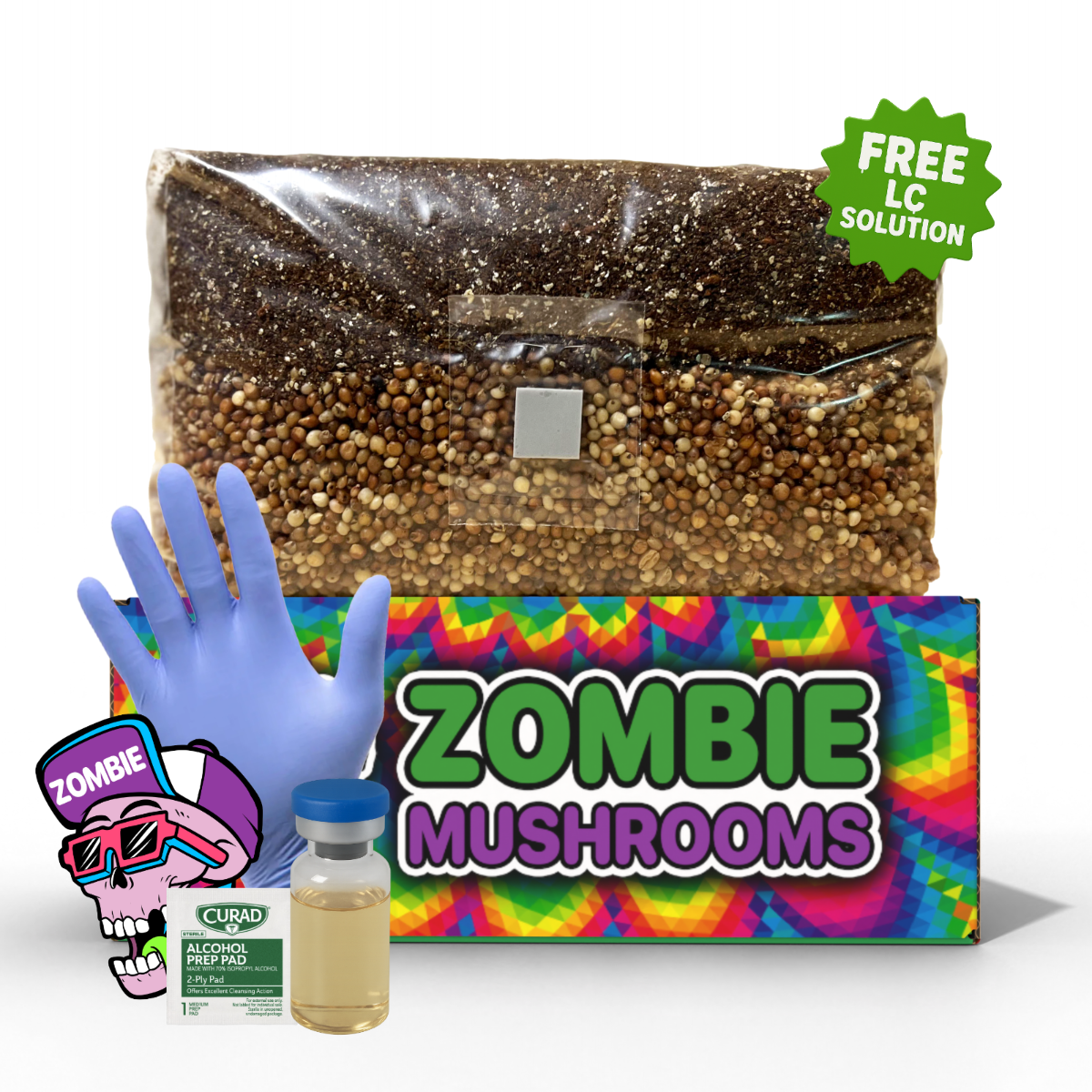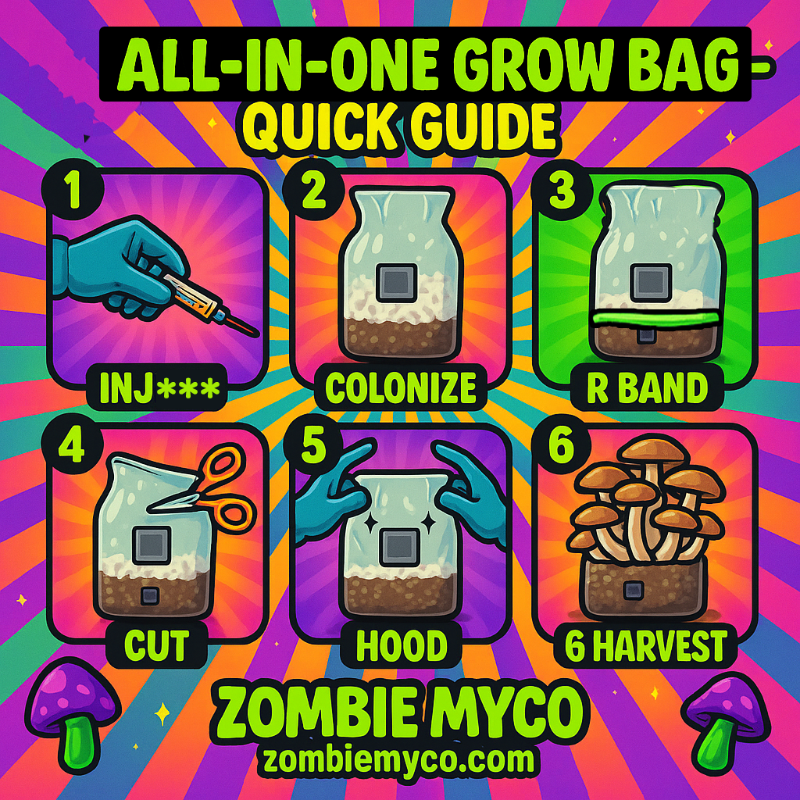⬇️ Prefer to listen instead? ⬇️
- ⚠️ Over 80% of mushroom growing problems stem from preventable contamination and environmental stressors.
- 🧫 Mold or bacterial outbreaks often indicate unsterile technique or improper substrate handling.
- 🌫️ CO₂ buildup drastically affects mushroom shape and yield due to restricted fresh air exchange.
- 💧 Mushrooms need steady high humidity (85–95%) for healthy pinning and fruiting but suffer when overwatered.
- 🌡️ Even slight temperature changes can disrupt colonization, pinning, or trigger abnormal growth.
Growing mushrooms at home offers flexibility, flavor, and even therapeutic benefits. But mistakes can make it feel hard. Growers can greatly improve their chances of success by learning about and fixing common mushroom growing problems. These include contamination, airflow issues, and unstable environments. Here, we will cover how to grow mushrooms well by preventing or fixing the most common mistakes that both new and experienced growers face. For beginners and experienced growers alike, our grow bags provide a reliable, low-maintenance setup that helps prevent many of the issues cultivators face.
1. Contamination: The #1 Mushroom Grower Struggle
Contamination is the biggest enemy of mushroom growing. It can quickly ruin a grow, reduce how much you get, or spread to other cultures if not dealt with. Contaminants are usually either fungal (like molds) or bacterial.
Mold Contamination Symptoms:
- Green, black, or blue fuzzy growth
- Mycelium covered or moved by mold patches
- Colonization suddenly stops.
Bacterial Contamination Symptoms:
- Wet, slimy patches
- Sour or rotting smell
- Yellow, orange, or soft tissue areas
Common Causes:
- Not using clean methods during inoculation
- Dirty tools, hands, or containers
- Open-air exposure without a HEPA-filter or still air box
- Contaminated spawn or improperly pasteurized substrate
Solutions:
- Clean Equipment: Always sterilize tools and work surfaces with 70% isopropyl alcohol.
- Protective Gear: Use gloves, face masks, and handle materials in clean conditions.
- Clean Spawn: Buy from trusted places like Zombie Mushrooms to lower the chance of contamination.
- Careful Inoculation: Use a still air box or laminar flow hood when moving cultures.
It's important to know that contamination is not always visible at first. The Mycological Society of America (2021) says that bacterial problems often start small, only visible under a microscope. They only show signs when it's too late to fix the damage.

2. Insufficient Fresh Air Exchange (FAE)
A common problem from growers is mushrooms appearing thin, leggy, or stopping growth after pins form. This usually happens because of not enough airflow and carbon dioxide (CO₂) buildup.
Why Fresh Air Matters
Mushrooms, like animals, breathe. They take in oxygen and release CO₂. During colonization, CO₂ can build up, and this is okay. But during fruiting, too much CO₂ is bad for them.
Symptoms of Poor FAE:
- Tall, thin mushrooms with tiny caps
- Fuzzy mycelium near the base (“fuzzy feet”)
- Caps turning yellow or pins forming slowly.
How to Improve Air Exchange:
- Ventilation: Fan your fruiting chamber 2–3 times daily if you're not using automated filters.
- Filtered Air Bags: Use grow bags with built-in filter patches so CO₂ can escape.
- Fans with Timers: Small, indirect airflow from inline fans or desktop units can greatly increase how much you get.
3. Humidity-Related Problems: Too Much or Too Little
Getting the humidity right is hard to do perfectly, but it is one of the key parts of growing mushrooms. Fruiting bodies need a very specific amount of water vapor in the air. If the levels are not steady, pins might die, bacterial spots can show up, or not enough mushrooms will fruit.
Signs of Low Humidity:
- Mushroom pins dry up or stop growing
- Substrate looks cracked or flaky
- Growing mushrooms shrivel early on.
Signs of High Humidity:
- Water pooling on mushrooms
- Brown or yellow blotches, which means bacterial blotch
- Fuzzy or white mold on walls or substrate.
Best Practices:
- Keep 85–95% Relative Humidity: Do this especially when pins are forming and during early fruiting stages (Kuo, 2012).
- Use a Hygrometer: Digital meters are cheap and a key tool.
- Mist Indirectly: Mist the air or walls, not the mushrooms directly.
- Humidifiers with Timers: These make humidity cycles steady and automatic.
Humidity in the air is always better than direct soaking or misting, which can harm small, easily harmed pins.
4. Improper Temperature Control
Each mushroom species needs certain temperatures to colonize and fruit well. Temperatures outside their range can stop growth or make contamination more likely.
Heat Stress (Too Hot):
Cold Stress (Too Cold):
- Pins do not start to form
- Mycelium stops growing
- Mushrooms grow slowly and stay small.
Recommended Temperature Ranges:
| Mushroom Species | Colonization Temp | Fruiting Temp |
|---|---|---|
| Oyster | 75–80°F | 60–75°F |
| Lion’s Mane | 70–75°F | 60–70°F |
| Shiitake | 72–76°F | 55–70°F |
Tips:
- Use a combination thermometer and hygrometer.
- Use mini space heaters or cooling fans based on room temperature.
- Keep the tent or greenhouse at a steady temperature by using insulation if needed.

5. Poor-Quality or Inappropriate Substrate
Think of the substrate as your mushroom's fuel tank. It must match the species' needs for both nutrients and moisture. Using low-quality or wrong substrates is a common mushroom growing problem.
Common Mistakes:
- Using straw for mushrooms that like wood, such as lion's mane or shiitake
- Substrate that is too dry or too wet after pasteurization
- Not enough sterilization when getting ready.
Solutions:
- Match substrate to species:
- Straw: Oysters grow well on this
- Hardwood sawdust: Best for lion’s mane or shiitake
- Check moisture by squeezing—it should feel like a wrung-out sponge
- Before fruiting, soak blocks for 4–6 hours in clean water to add moisture back.
Pre-sterilized grow kits are a great shortcut, especially when starting out.

6. Using Contaminated or Weak Spawn
You will only get many mushrooms if your spawn has good genetics and is clean. Bad spawn can bring problems even to a clean growing area.
Symptoms of Bad Spawn:
- Colonization that stops or is uneven
- Slimy feel or grains that smell bad
- Mycelium that is weak or grows slowly.
How to Avoid:
- Buy from trusted brands like Zombie Mushrooms, known for clean ways of making their products.
- Check dates and storage instructions carefully.
- Store spawn in a refrigerator (35–45°F) if not used right away.
Healthy spawn looks bright white, quickly grows through its medium, and does not smell sour or bad.

7. Ineffective Sterilization or Pasteurization
Knowing the difference between sterilization and pasteurization is very important to prevent contamination while keeping the substrate able to grow.
Know Your Process:
- Pasteurization (140–160°F): For substrates with few nutrients, such as straw or coir.
- Sterilization (250°F): For materials with many nutrients, such as grains or sawdust with added nutrients.
Tips for Proper Practice:
- Use a pressure cooker for sterilizing.
- Always cool materials completely before inoculation.
- Place sterilized items in clean places until used.
Skipping or cutting corners here is one of the fastest ways contamination gets in.

8. Inconsistent Light Exposure
Lighting does not directly feed mushrooms. But it affects how pins develop and how they grow towards light (phototropism).
Common Lighting Issues:
- Mushrooms lean a lot toward the light source
- Uneven or pins forming slowly
- Tall but thin, unstable mushrooms.
Lighting Solutions:
- Use 12-hour light/dark cycles
- Install LED grow strips with timers
- Avoid direct UV or sunlight as it dries pins
Light acts as a signal, not a growth source. People often misunderstand this part of mushroom growth.

9. Overhandling or Premature Harvesting
Touching the container often upsets its small environment. Harvesting too early lowers how much you get and does not allow spores or mushrooms to fully grow.
Don't Do:
- Touch or mist directly onto young pins
- Open bags multiple times a day
- Pluck early due to excitement
Ideal Harvest Time:
- When caps begin to flatten out
- Right before veil breaks (for spore-bearing species)
- Twist gently or slice at the base to avoid harming surrounding mycelium
Harvesting properly makes a good second flush more likely.

10. Pin Abortion: Stalled Mushroom Growth
Your pins were coming in strong, and then suddenly shriveled. This is one of the most frustrating mushroom growing problems: pin abortion.
Causes:
- Sudden dry air when pins are forming
- Misting young mushrooms too much
- Temperature or air exchange changes.
Prevention Tactics:
- Keep steady humidity with indirect misting
- Use clear lids or domes over trays to keep a steady small environment
- Leave pins alone and avoid opening bags often.
Once a pin dies, that spot likely will not grow back until the next flush.
11. Mold After First Flush: How to Deal
After the first flush, the substrate is weak. This allows mold, mildew, and bacteria to grow. Like your body after a flu, the substrate is at risk while it gets better.
When to Reuse the Block:
- No mold growing
- Still has a firm shape and active mycelium (white fuzzy patches)
- No bad smell.
Rehydrating for New Flush:
- Soak block for 4–6 hours in clean water
- Drain well to avoid rot from lack of air
- Place back into the fruiting chamber with good airflow.
When to Compost:
- Any green, black, or brightly colored fuzzy growth
- Strong ammonia or sour smell
- High chance of contamination spreading to nearby blocks.

12. Choosing the Wrong Kit or Species
Mismatch in environment often spoils beginner grows. Some species grow well in cooler temperatures and high humidity. Others do better in less-than-perfect setups.
Best Choices by Environment:
- Warm Indoor Air: Try king oyster or pink oyster (70–85°F)
- Cool Basements: Shiitake and lion's mane (55–70°F)
- Low-Humidity Regions: Reishi or enclosed tent with humidifier
Visit growers' forums or product-specific guides before choosing a species. Zombie Mushrooms makes kits specifically for North American indoor environments, so they work well.

13. Building a Controlled Grow Environment
Whether inside a closet or small greenhouse, a steady environment is vital for success over time.
Must-Have Tools:
- Mini humidifier with timer
- Thermometer/hygrometer combo
- Still air box or HEPA-filtered area for clean work
- Filtered fresh air inlet
- Fans for removing still air.
Keeping a grow journal or spreadsheet is very important. Write down RH (relative humidity), temperature, how they grow, and how much you get per flush to slowly make your conditions just right.
Growing mushrooms takes skill, science, and patience. You will learn about mushroom contamination problems or how to adjust humidity and lighting. And every failed flush builds experience. You can turn even hard grows into good flushes by dealing with the main mushroom growing problems and following good practices. Want help getting started? Find high-quality grow kits and supplies for beginners at Zombie Mushrooms to make learning easier.
References
Kuo, M. (2012). Understanding Mushroom Growth: Importance of Humidity and Temperature. MushroomExpert.com.
Mycological Society of America. (2021). Common Contaminants in Mushroom Cultivation.
Stamets, P. (2000). Growing Gourmet and Medicinal Mushrooms (3rd ed.). Ten Speed Press.
USDA Agricultural Research Service. (2020). Postharvest Handling of Edible Mushrooms.
Ready to fix your grow problems and improve your growing? Find beginner-friendly kits, fresh spawn, and clean supplies at Zombie Mushrooms to start growing with more certainty.



